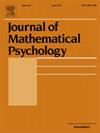知识结构的维度
IF 2.2
4区 心理学
Q2 MATHEMATICS, INTERDISCIPLINARY APPLICATIONS
引用次数: 0
摘要
当一个知识结构的状态集合形成一条链时,它本质上是一维的。但是一般来说,如何定义知识结构的维度呢?我们研究了四种选项:(i)有序维度,它是由包含有序的所有状态组成的偏序集的维度;(ii)对于知识空间,指产生该空间的一维知识空间数量最少的空间维度(从学习空间扩展到知识空间的概念,即反矩阵的凸维的对偶);(iii)二维,这是从项目到状态的隶属关系的二维,在二维的交集或联合版本中。我们的结果建立或反驳了知识结构、知识空间、简洁知识结构、简洁知识空间和学习空间的四维参数之间的不等式。最后提出了一些有待进一步研究的问题。本文章由计算机程序翻译,如有差异,请以英文原文为准。

Dimensions of knowledge structures
A knowledge structure is inherently one-dimensional when its collection of states forms a chain. But how to define the dimension of a knowledge structure in general? We investigate four options: (i) the ordinal dimension, which is the dimension of the poset consisting of all states ordered by inclusion; (ii) for a knowledge space, the spatial dimension which is the least number of one-dimensional knowledge spaces which generate the space (a notion extending from learning spaces to knowledge spaces the dual of the convex dimension of an antimatroid); (iii) the bidimension, which is the bidimension of the membership relation from items to states, in either the intersection or the union version of the bidimension. Our results establish or disprove inequalities among the four dimension parameters for knowledge structures, for knowledge spaces, for terse knowledge structures, for terse knowledge spaces, and finally for learning spaces. We finally list some problems for future research.
求助全文
通过发布文献求助,成功后即可免费获取论文全文。
去求助
来源期刊

Journal of Mathematical Psychology
医学-数学跨学科应用
CiteScore
3.70
自引率
11.10%
发文量
37
审稿时长
20.2 weeks
期刊介绍:
The Journal of Mathematical Psychology includes articles, monographs and reviews, notes and commentaries, and book reviews in all areas of mathematical psychology. Empirical and theoretical contributions are equally welcome.
Areas of special interest include, but are not limited to, fundamental measurement and psychological process models, such as those based upon neural network or information processing concepts. A partial listing of substantive areas covered include sensation and perception, psychophysics, learning and memory, problem solving, judgment and decision-making, and motivation.
The Journal of Mathematical Psychology is affiliated with the Society for Mathematical Psychology.
Research Areas include:
• Models for sensation and perception, learning, memory and thinking
• Fundamental measurement and scaling
• Decision making
• Neural modeling and networks
• Psychophysics and signal detection
• Neuropsychological theories
• Psycholinguistics
• Motivational dynamics
• Animal behavior
• Psychometric theory
 求助内容:
求助内容: 应助结果提醒方式:
应助结果提醒方式:


